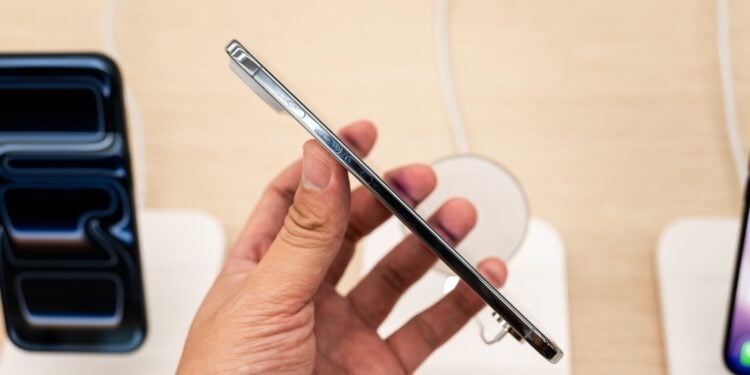The iPhone Air was supposed to be the lightest and thinnest iPhone ever—a technical statement that prioritizes design over everything else. But the reality is sobering. Demand is falling far short of expectations, and Apple is forced to react. According to analyst Ming-Chi Kuo, iPhone Air production is being drastically scaled back. The supply chain is predicting a decline of more than 80 percent by early 2026.
Apple had big plans for the iPhone Air. It was supposed to offer the perfect blend of lightness, elegance, and high-end technology. But the concept seems to have missed the market. Consumers continue to choose the classic models—especially the iPhone 17 variants. The iPhone Air is falling by the wayside. Analysts and industry reports paint a clear picture: Production is shrinking, demand is collapsing, and suppliers are preparing to withdraw.
Production decline of 80 percent
According to well-known Apple analyst Ming-Chi Kuo, the weak demand for the iPhone Air is having a direct impact on the entire supply chain. Suppliers are expected to reduce their production capacity by more than 80 percent by the first quarter of 2026. Components with longer delivery times are expected to be phased out by the end of 2025.
Kuo sees this as a clear signal: The iPhone 17 models—the standard and Pro models—already cover most of the demand in the high-end segment. There's hardly any room left for an additional, particularly thin model. The iPhone Air apparently can't differentiate itself sufficiently from the rest of the product line to attract its own buyer segment.
Weak sales figures and drastic cuts
Other sources also confirm the poor sales figures. Japan's Mizuho Securities recently reported that Apple had reduced production by around one million units. According to a report by the Nikkei business news service, there is "virtually no demand" for the iPhone Air. Apple has cut production "drastically" – an unusually significant step for a device that was only recently launched.
A recurring weakness in niche models
The iPhone Air isn't the first model Apple has tried to fill a market gap—and failed. The 5.4-inch iPhone mini was intended to be a compact premium device, but it barely found any buyers. Apple then tried the iPhone Plus, a cheaper and larger alternative to the Pro Max. This model also fell short of expectations.
With the iPhone Air, Apple opted for an extremely slim design, measuring just 5.6 millimeters thick. This made the device impressively light, but also technically limited. The battery, camera, and cooling system had to save space. This was noticeable in everyday use – and apparently, many buyers opted for the tried-and-tested iPhone 17 models instead.
Competition with similar problems
Even Samsung, Apple's biggest competitor, is struggling with the same problem. The Galaxy S25 Edge, also a particularly thin smartphone, sold significantly worse than expected. According to reports, development of a successor has even been discontinued. Apparently, ultra-thin smartphones are not a mass trend, but a niche experiment that simply doesn't appeal to many consumers.
Looking ahead: The foldable iPhone as the next attempt
Despite the disappointment with the iPhone Air, Apple appears to already be working on its next big idea. A foldable iPhone is expected for 2026, which will be part of the upcoming iPhone 18 series. This model could open a new chapter and demonstrate that innovation doesn't stand still at Apple. After the setback with the iPhone Air, the company is likely doing everything it can to surprise again – this time with technology that offers real added value.
The iPhone Air shows the limits of lightness
The iPhone Air was intended as a bold design experiment, but it failed to achieve market success. An 80 percent production cut is a clear sign that the strategy didn't work. Apple attempted to set new standards with lightness and form, but performance, battery life, and functionality fell by the wayside. The lesson: Not every experiment finds its place in users' everyday lives. While the iPhone Air is slowly being phased out, Apple is already looking to the future – to new formats and perhaps a foldable iPhone that better strikes the balance between innovation and utility. (Image: Shutterstock / Wongsakorn 2468)
- Apple stock in focus: Wells Fargo raises target to $290
- Apple Vision Pro not eligible for trade-in, according to Apple
- Apple is working on a tool for app data migration to Android
- iPhone Air weakens – Apple relies on other models
- Apple Vision Pro – Apple relies on Vietnam for manufacturing
- Samsung Galaxy XR – The new mixed reality experience
- iPhone 17 Pro turning pink? What's really behind it?
- iPhone 17 booming – Wedbush raises price target for Apple
- M5 MacBook Pro Reviews: Apple's professional laptop in a detailed test
- Apple Vision Pro 2025 reviews: More stable, sharper, better
- New AI browser ChatGPT Atlas: More than just a search
- Shrinking Season 3 starts in January 2026 on Apple TV
- WhatsApp warns of fraud: New protection feature active
- M5 iPad Pro reviews: More power, less limit
- Apple takes legal action against the Digital Markets Act
- Apple lawsuit without resistance: Prosser lets deadline pass





